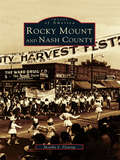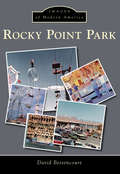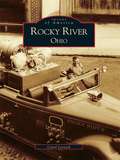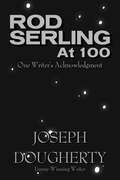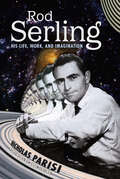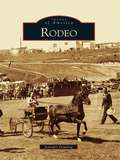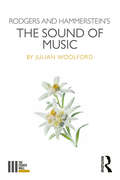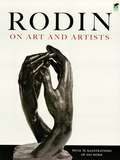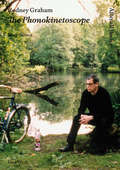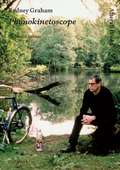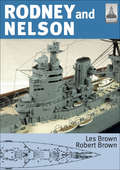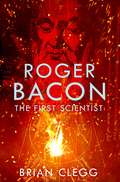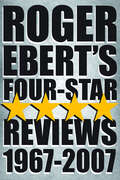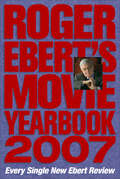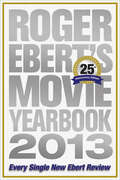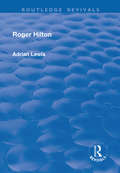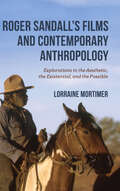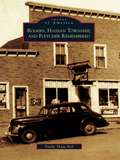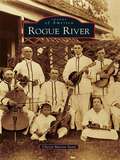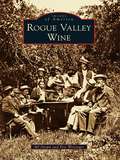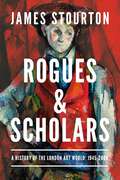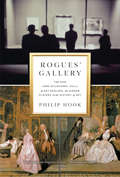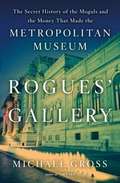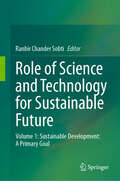- Table View
- List View
Rocky Mount & Nash County (Images of America)
by Monika S. FlemingThe picturesque beauty and unique history of Rocky Mount, North Carolina, are surpassed only by the strength of character of the region's citizens. In this new and singular pictorial history, all of these wonderful attributes are portrayed in vibrant detail. The first historical retrospective of Nash County to appear in 20 years, Rocky Mount and Nash County encompasses many of the county's smaller towns and crossroads and chronicles the development of industry, agriculture, and business, as well as the remarkable people who call the region home, in rich visual imagery and intriguing anecdotes.
Rocky Point Park
by David BettencourtIn 1938, a tremendous hurricane devastated southern New England, including Rocky Point Park. The shore dining hall was washed away, and the roller coaster lay in ruins. Owners began to look into other options for this beautiful 80 acres of land along the coastline of Narragansett Bay. The park's future was in jeopardy until 1948, when Providence businessman Vincent Ferla bought it and brought it back to life. He revitalized the midway and brought in new and exciting rides, and on the park's first day back, more than 35,000 people visited. The park thrived for nearly 50 years until its eventual closure in 1995. Today, this scenic spot along the Atlantic Ocean has been returned to the people of Rhode Island as a nature preserve and is flourishing once again.
Rocky River Ohio
by Carol LestockRocky River, Ohio, was originally part of a large township that encompassed Lakewood, Rocky River, Fairview Park, and the West Park neighborhood of Cleveland. Gideon Granger, an early settler to the region, believed that this area at the mouth of the Rocky River would one day be a major city and port, surpassing Cleveland in size and importance. Happily, Granger's vision did not come true. Rocky River continues to remain a small town in every good sense of the word. The early history and development of Rocky River unfold through the images collected in this volume. This visual history serves as a tour guide to the town's past, from its beginning through to the present day. For the first time readers will see the history of Rocky River, its most notable landmarks and events, and be able to relate it all to the town they know today.
Rod Serling at 100: One Writer's Acknowledgment
by Joseph DoughertyEmmy-winning writer and lifelong Rod Serling fan Joseph Dougherty (thirtysomething, Pretty Little Liars) takes a deep dive into the writing of the Twilight Zone creator on the occasion of his 100th birthday.The year 2024 marks the centenary of Rod Serling, creator of The Twilight Zone and Night Gallery. Emmy-winning writer Joseph Dougherty (thirtysomething, Pretty Little Liars) picked this special anniversary to reflect on Serling and his contributions to television drama. An appreciation and exploration of the six-time Emmy-winning writer&’s catalogue, Rod Serling at 100: One Writer&’s Acknowledgment looks at some of Serling&’s best known work and also some of his least acknowledged, inviting a new perspective on a master storyteller. In the process, Dougherty takes a personal look at the time he spent in The Twilight Zone that led to his own award-winning writing career
Rod Serling: His Life, Work, and Imagination
by Nicholas ParisiLong before anyone had heard of alien cookbooks, gremlins on the wings of airplanes, or places where pig-faced people are considered beautiful, Rod Serling was the most prestigious writer in American television. As creator, host, and primary writer for The Twilight Zone, Serling became something more: an American icon. When Serling died in 1975, at the age of fifty, he was the most honored, most outspoken, most recognizable, and likely the most prolific writer in television history. Though best known for The Twilight Zone, Serling wrote over 250 scripts for film and television and won an unmatched six Emmy Awards for dramatic writing for four different series. His filmography includes the acclaimed political thriller Seven Days in May and cowriting the original Planet of the Apes. In great detail and including never-published insights drawn directly from Serling’s personal correspondence, unpublished writings, speeches, and unproduced scripts, Nicholas Parisi explores Serling’s entire, massive body of work. With a foreword by Serling’s daughter, Anne Serling, Rod Serling: His Life, Work, and Imagination is part biography, part videography, and part critical analysis. It is a painstakingly researched look at all of Serling’s work—in and out of The Twilight Zone.
Rodeo (Images of America)
by Jennifer DowlingRodeo, located on the east shore of San Pablo Bay, was envisioned as the meatpacking center of the West when it was established by the Union Stockyard Company in 1890. That vision failed, but the town continued attracting residents for jobs at the nearby Hercules powder works, Selby smelter, and Oleum refinery. By the 1940s, a war-based industrial buildup made Rodeo's population surge, and this was followed by a postwar boom in housing and retail construction. During these prosperous years, Rodeo was a regional hub for fishing and boating. Times have changed, but the images in these pages recall Rodeo's early years--the marina, businesses and homes, schools, civic officials, and local industry, as well as the town's celebrations, such as the Holy Ghost and Aquatic Festivals.
Rodgers and Hammerstein's The Sound of Music (The Fourth Wall)
by Julian Woolford'Blossom of snow may you bloom and grow, Bloom and grow forever' Often dismissed as kitsch sentimentalism, Rodgers and Hammerstein’s The Sound of Music has proven an enduringly popular and surprisingly influential cultural icon, both within the field of musical theatre and the wider world. The Broadway production won five Tony Awards, the London production became the longest-running West End musical, and the movie version was the highest-grossing film of all time. This book examines how the musical heralded the end of an era on Broadway; its reinvention of history and biography; how the film has influenced future stage productions; the ways in which it put child performers centre stage; and how, nearly 60 years after its stage debut, the musical still has a direct impact on the modern world, from the United States to the Middle East. In this series of short essays, Julian Woolford re-examines the musical from seven different perspectives, revealing the ways in which it continues to impact the 21st century.
Rodin on Art and Artists
by Auguste RodinThe greatest sculptor of the nineteenth century discusses his philosophy of life with a close friend in this fascinating and informative artistic testament. Auguste Rodin spoke candidly to his protégé, Paul Gsell, who recorded the master's thoughts not only about the technical secrets of his craft, but also about its aesthetic and philosophical underpinnings.Here is the real Rodin--relaxed, intimate, open, and charming--offering a wealth of observations on the relationship of sculpture to poetry, painting, theater, and music. He also makes perceptive comments on Rembrandt, Michelangelo, Raphael, and other great artists, and he shares revealing anecdotes about Hugo, Balzac, and others who posed for him. Seventy-six superb illustrations of the sculptor's works complement the text, including St John the Baptist Preaching, The Burghers of Calais, The Thinker, and many others, along with a selection of exuberant drawings and prints.
Rodney Graham: Phonokinetoscope (One Work)
by Shepherd SteinerAn examination of the complex and subtle world on display in Rodney Graham's film of an LSD-inflected bicycle ride. Rodney Graham's Phonokinetoscope (2001) is a five-minute 16mm film loop in which the artist is seen riding his Fischer Original bicycle through Berlin's Tiergarten while taking LSD, to the soundtrack of a fifteen-minute song (written and performed by Graham) recorded on a vinyl LP. The turntable drives the projection of the film; the film starts when the needle is placed on the record and stops when the needle is taken off. Graham's ride evokes the Swiss scientist Albert Hoffman's famous 1943 bicycle ride home after an experimental dose of LSD as well as Paul Newman's backward-facing ride in Butch Cassidy and the Sundance Kid; the accompanying music presents a thicket of riffs and borrowings. As the images and visual details repeat in the film's endless loop, the artist's Phonokinetoscope refers to a surprising number of works of art and literature, displaying a world rich with subtle meaning. In this illustrated study of Phonokinetoscope, Shep Steiner describes the work as marking Graham's transition into a new medium. Steiner positions Graham's practice in relation to postminimalist practice and that of other artists including Dan Graham, but especially, Ian Wallace and Jeff Wall; considers Graham's rhetoric of playfulness; and finally, beyond the web of references, argues for a notion of allegory and memory theater keyed to the durational work yet satisfying the aesthetic standards of static art. Phonokinetoscope, Steiner argues, looks back to Graham's earlier works focusing on the notion of protocinema and forward to his later musical preoccupations.
Rodney Graham: The Phonokinetoscope
by Shep SteinerRodney Graham's "Phonokinetoscope" (2001) is a five-minute 16mm film loop in which the artist is seen riding his Fischer Original bicycle through Berlin's Tiergarten while taking LSD, to the soundtrack of a fifteen-minute song (written and performed by Graham) recorded on a vinyl LP. The turntable drives the projection of the film; the film starts when the needle is placed on the record and stops when the needle is taken off. Graham's ride evokes the Swiss scientist Albert Hoffman's famous 1943 bicycle ride home after an experimental dose of LSD as well as Paul Newman's backward-facing ride in "Butch Cassidy and the Sundance Kid"; the accompanying music presents a thicket of riffs and borrowings. As the images and visual details repeat in the film's endless loop, the artist's "Phonokinetoscope" refers to a surprising number of works of art and literature, displaying a world rich with subtle meaning. In this illustrated study of "Phonokinetoscope," Shep Steiner describes the work as marking Graham's transition into a new medium. Steiner positions Graham's practice in relation to postminimalist practice and that of other artists including Dan Graham, but especially, Ian Wallace and Jeff Wall; considers Graham's rhetoric of playfulness; and finally, beyond the web of references, argues for a notion of allegory and memory theater keyed to the durational work yet satisfying the aesthetic standards of static art. "Phonokinetoscope," Steiner argues, looks back to Graham's earlier works focusing on the notion of protocinema and forward to his later musical preoccupations.
Rodney and Nelson (ShipCraft #23)
by Robert Brown Les Brown&“Simply the best reference for any model maker&” on the most instantly recognizable British battleships in history (Warship World). The ShipCraft series provides in-depth information about building and modifying model kits of famous warship types. Lavishly illustrated, each book takes the modeler through a brief history of the subject class, highlighting differences between sisterships and changes in their appearance over their careers. This includes paint schemes and camouflage, featuring color profiles and highly detailed line drawings and scale plans. The modeling section reviews the strengths and weaknesses of available kits, lists commercial accessory sets for super-detailing of the ships, and provides hints on modifying and improving the basic kit. This is followed by an extensive photographic survey of selected high-quality models in a variety of scales, and the book concludes with a section on research references—books, monographs, large-scale plans and relevant websites. The two ships covered in this volume were the only capital ships designed and built between the wars—a special concession of the Washington Treaty&’s ban on new battleships—and they were unlike anything before them, with the superstructure three-quarters aft and all main armament turrets forward of the bridge. During the war, Nelson survived mine and torpedo damage, while Rodney played a major part in the destruction of the Bismarck, both surviving to be broken up post-war.
Roger Bacon: The First Scientist
by Brian CleggBack in thirteenth-century Europe, in the early years of the great universities, learning was spiced with the danger of mob violence and a terrifyingly repressive religious censorship. Roger Bacon, a humble and devout English friar, seems an unlikely figure to challenge the orthodoxy of his day - yet he risked his life to establish the basis for true knowledge.Born c.1220, Bacon was passionately interested in the natural world and how things worked. Such dangerous topics were vetoed by his Order, and it was only when a new Pope proved sympathetic that he began compiling his encyclopaedia on everything from optics to alchemy - the synopsis took a year and ran to 800,000 words and he was never to complete the work itself. Sadly, the enlightened Pope died, and Bacon was tried as a magician and incarcerated for ten years. Legend transformed Bacon into a sorcerer, 'Doctor Mirabilis', yet he taught that all magic was based on fraud, and his books were the first flowering of the scientific thinking that would transform our world. He advanced the understanding of optics, made geographical breakthroughs later used by Columbus, predicted everything from horseless carriages to the telescope, and stressed the importance of mathematics to science, a significance ignored for 400 years. His biggest contribution was to insist that a study of the natural world by observation and exact measurement was the surest foundation for truth. Clegg uncovers the realities of life in a medieval university and friary, setting out the shadowy facts of Bacon's life alongside his writings. The result is both a fascinating biography and a picture of the age.
Roger Bacon: The First Scientist
by Brian CleggBack in thirteenth-century Europe, in the early years of the great universities, learning was spiced with the danger of mob violence and a terrifyingly repressive religious censorship. Roger Bacon, a humble and devout English friar, seems an unlikely figure to challenge the orthodoxy of his day - yet he risked his life to establish the basis for true knowledge.Born c.1220, Bacon was passionately interested in the natural world and how things worked. Such dangerous topics were vetoed by his Order, and it was only when a new Pope proved sympathetic that he began compiling his encyclopaedia on everything from optics to alchemy - the synopsis took a year and ran to 800,000 words and he was never to complete the work itself. Sadly, the enlightened Pope died, and Bacon was tried as a magician and incarcerated for ten years. Legend transformed Bacon into a sorcerer, 'Doctor Mirabilis', yet he taught that all magic was based on fraud, and his books were the first flowering of the scientific thinking that would transform our world. He advanced the understanding of optics, made geographical breakthroughs later used by Columbus, predicted everything from horseless carriages to the telescope, and stressed the importance of mathematics to science, a significance ignored for 400 years. His biggest contribution was to insist that a study of the natural world by observation and exact measurement was the surest foundation for truth. Clegg uncovers the realities of life in a medieval university and friary, setting out the shadowy facts of Bacon's life alongside his writings. The result is both a fascinating biography and a picture of the age.
Roger Ebert's Four-Star Reviews 1967–2007
by Roger EbertSpanning the length of Roger Ebert's career as the leading American movie critic, this book contains all of his four-star reviews written during that time. A great guide for movie watching.
Roger Ebert's Movie Yearbook 2007: Every Single New Ebert Review
by Roger EbertThe most-trusted film critic in America." --USA Today Roger Ebert actually likes movies. It's a refreshing trait in a critic, and not as prevalent as you'd expect." --Mick LaSalle, San Francisco ChronicleAmerica's favorite movie critic assesses the year's films from Brokeback Mountain to Wallace and Gromit: The Curse of the Were-Rabbit. Roger Ebert's Movie Yearbook 2007 is perfect for film aficionados the world over.Roger Ebert's Movie Yearbook 2007 includes every review by Ebert written in the 30 months from January 2004 through June 2006-about 650 in all. Also included in the Yearbook, which is about 65 percent new every year, are:* Interviews with newsmakers such as Philip Seymour Hoffman, Terrence Howard, Stephen Spielberg, Ang Lee, and Heath Ledger, Nicolas Cage, and more.* All the new questions and answers from his Questions for the Movie Answer Man columns.* Daily film festival coverage from Cannes, Toronto, Sundance, and Telluride.*Essays on film issues and tributes to actors and directors who died during the year.
Roger Ebert's Movie Yearbook 2013: Every Single New Ebert Review
by Roger EbertRoger Ebert&’s &“criticism shows a nearly unequaled grasp of film history and technique, and formidable intellectual range. . . .&” —New York TimesPulitzer Prize–winning film critic Roger Ebert presents more than 600 full-length critical movie reviews, along with interviews, tributes, and journal entries inside Roger Ebert&’s Movie Yearbook 2013.It includes every movie review Ebert has written from January 2010 to July 2012.Also included in the Yearbook:In-depth interviews with newsmakers and celebritiesTributes to those in the film industry who have passed away recentlyEssays on the Oscars, reports from the Toronto Film Festival, and entries into Ebert's Little Movie Glossary
Roger Hilton
by Adrian LewisThis title was first published in 2003. Twenty-seven years after his death, Roger Hilton's reputation as a leading figure in British 'abstract expressionism' continues to rise. Following the major retrospective exhibition at the Hayward Gallery in 1993 and the drawings survey at the Tate St Ives in 1997, this lavishly illustrated account is the first to provide a comprehensive overview of the life and work of this important artist. Hilton's extraordinary career is discussed in all its phases, from the intriguing earliest explorations in paint to the inception of his first abstract pieces around 1950 and the complex and intriguing interchanges of imagery and form that mark his final works. Adrian Lewis explains the artist's mature works as both attracting the viewer and resisting easy reading, and discusses in detail the artist's debt to the Ecole de Paris and his relation to the notion of the 'act of painting' that pervaded post-war culture.
Roger Sandall's Films and Contemporary Anthropology: Explorations in the Aesthetic, the Existential, and the Possible
by Lorraine MortimerA look at a prize-winning documentarian whose work with aboriginal Australians and others united the fields of film and anthropology in the 1960s and ‘70s.In Roger Sandall’s Films and Contemporary Anthropology, Lorraine Mortimer argues that while social anthropology and documentary film share historic roots and goals, particularly on the continent of Australia, their trajectories have tended to remain separate. This book reunites film and anthropology through the works of Roger Sandall, a New Zealand–born filmmaker and Columbia University graduate, who was part of the vibrant avant-garde and social documentary film culture in New York in the 1960s.Mentored by Margaret Mead in anthropology and Cecile Starr in fine arts, Sandall was eventually hired as the one-man film unit at the newly formed Australian Institute of Aboriginal Studies in 1965. In the 1970s, he became a lecturer in anthropology at the University of Sydney. Sandall won First Prize for Documentary at the Venice Film Festival in 1968, yet his films are scarcely known, even in Australia now. Mortimer demonstrates how Sandall’s films continue to be relevant to contemporary discussions in the fields of anthropology and documentary studies. She ties exploration of the making and restriction of Sandall’s aboriginal films and his nonrestricted films made in Mexico, Australia, and India to the radical history of anthropology and the resurgence today of an expanded, existential-phenomenological anthropology that encompasses the vital connections between humans, animals, things, and our environment.
Rogers, Hassan Township, and Fletcher Remembered (Images of America)
by Paulie Skaja-BellThe heavily wooded area of western Hennepin County, known as the "Big Woods" to early explorers, slowly transformed into three trade centers with the first permanent settlers staking their claims to land in 1854. The initial pioneers emigrated from such faraway places as Germany, Ireland, England, and France in search of a better life, and the fact that many of their ancestors still reside in the area demonstrates they found just that. Rogers, Hassan Township, and Fletcher Remembered is a photographic tour of three early trade centers that formed a community. The pictures, newspaper clippings, and stories provided by local residents and businesses capture the rich history of the area and illustrate how emphasis on church, education, commerce, and entertainment created the endless opportunities enjoyed today.
Rogue River (Images of America)
by Cheryl Martin SundThe town of Rogue River is a small community in southern Oregon located on the banks of the famous river for which it was named. Situated on Interstate 5, just 59 miles north of the California border, it lies between the cities of Grants Pass and Medford in the beautiful Rogue Valley. Founded in the midst of Native American wars and prolific gold mining, the town was originally called Tailholt before becoming Woodville. It incorporated and took its final name in 1912. A town proud of its accomplishments, it has nevertheless managed to preserve its history and maintain its small-town atmosphere and historical value, with many of the original buildings still in use. Along with sensational steelhead fishing, Rogue River is famous for its annual Rooster Crow festivities held on the last Saturday of each June.
Rogue Valley Wine (Images of America)
by Mj Daspit Eric WeisingerWinemaking in Oregon began more than 150 years ago when Peter Britt of Jacksonville brought grapevine cuttings from California to create his Valley View Vineyard. By 1890, the Southern Oregon State Board of Agriculture forecast a vineyard-dotted Rogue Valley to rival "the castled Rhine, the classical vales of Italy and the sunny slopes of France." But Prohibition, which became law in Oregon four years before the rest of the country, killed the nascent industry. Not until the 1970s, when Americans discovered a passion for wine, was winegrowing and winemaking in Southern Oregon's Rogue Valley reestablished. Pear orchards were converted to vineyards, and winemaking--not on a California scale, but rather in boutique wineries tucked away along scenic country roads--began anew and thrived.
Rogues and Scholars: A History of the London Art World: 1945-2000
by James StourtonA colorful and fast-moving account of how postwar London became the global center of the art market—a story of Impressionist masterpieces, dodgy dealers, and ground-breaking financial transactions.On October 15, 1958, Sotheby's of Bond Street staged an "event sale&” of seven Impressionist paintings belonging to Erwin Goldschmidt: three Manets, two Cézannes, one Van Gogh, and a Renoir. Kirk Douglas, Anthony Quinn, and Somerset Maugham were there as celebrity guests. The seven lots went for £781,000—at the time the highest price for a single sale. The event established London as the world center of the art market and Sotheby's as an international auction house. It began a shift in power from the dealers to the auctioneers and paved the way for Impressionist paintings to dominate the market for the next forty years. Sotheby's had pulled off a massive coup by capturing the Impressionist market from Paris and New York—and now began its inexorable rise, opening offices all over the world. A huge expansion of the market followed, accompanied by rocketing prices, colorful scandals, and legal dramas. London transformed itself from a fusty place of old master painting sales to a revitalized center of contemporary art, crowned by the opening of Tate Modern in 2000. The Tate Modern successfully united new (and mostly foreign) money in London with the art world, offering its patrons a ready-made sophisticated social milieu alongside dealers in contemporary art. In a vibrant and briskly-paced style, James Stourton tells the story of the London art market from the immediate postwar period to the turn of the millennium. While Sotheby's is the lynchpin of this story, Stourton populates his narrative with a glorious rogue's gallery of eccentric scholars, clever amateurs, brilliant emigrés, and stylish grandees with a flair for the deal.
Rogues' Gallery: The Rise (and Occasional Fall) of Art Dealers, the Hidden Players in the History of Art
by Philip HookHere for the first time is the history of art dealers, those extraordinary men and woman who, over centuries (and almost entirely out of the public eye), built their profession on a singular skill: identifying the intangible but infinitely desirable qualities that characterize the greatest works of art—and finding clients for whom those qualities are irresistible. Philip Hook’s riveting narrative takes us from the early days of art dealing in Antwerp, where paintings were sold by weight, to the unassailable hauteur of contemporary galleries in New York, London, Paris, and beyond. Along the way, we meet a surprisingly wide-ranging cast of characters—from tailors, spies, and the occasional anarchist to scholars, aristocrats, and connoisseurs, some compelled by greed, some by their own vision of art—and some by the art of the deal. Among them are Joseph Duveen, who almost single-handedly brought the Old Masters to America; Paul Durand-Ruel, the Impressionists’ champion; Daniel-Henry Kahnweiler, high priest of Cubism; Leo Castelli, dealer-midwife to Abstract Expressionism and Pop Art; and Peter Wilson, the charismatic Sotheby’s chairman who made a theater of the auction room.Rogues’ Gallery bursts with unforgettable anecdotes and astute judgments about art and artists, honed by Hook’s more than forty years in the art market—making it essential reading for anyone interested in the hidden history of art.
Rogues' Gallery: The Secret Story of the Lust, Lies, Greed, and Betrayals That Made the Metropolitan Museum of Art
by Michael Gross“Behind almost every painting is a fortune and behind that a sin or a crime.” <P><P> With these words as a starting point, Michael Gross, leading chronicler of the American rich, begins the first independent, unauthorized look at the saga of the nation’s greatest museum, the Metropolitan Museum of Art. In this endlessly entertaining follow-up to his bestselling social history 740 Park, Gross pulls back the shades of secrecy that have long shrouded the upper class’s cultural and philanthropic ambitions and maneuvers. And he paints a revealing portrait of a previously hidden face of American wealth and power.<P> The Metropolitan, Gross writes, “is a huge alchemical experiment, turning the worst of man’s attributes—extravagance, lust, gluttony, acquisitiveness, envy, avarice, greed, egotism, and pride—into the very best, transmuting deadly sins into priceless treasure.” The book covers the entire 138-year history of the Met, focusing on the museum’s most colorful characters. Opening with the lame-duck director Philippe de Montebello, the museum’s longest-serving leader who finally stepped down in 2008, Rogues’ Gallery then goes back to the very beginning, highlighting, among many others: the first director, Luigi Palma di Cesnola, an Italian-born epic phony, whose legacy is a trove of plundered ancient relics, some of which remain on display today; John Pierpont Morgan, the greatest capitalist and art collector of his day, who turned the museum from the plaything of a handful of rich amateurs into a professional operation dedicated, sort of, to the public good; John D. Rockefeller Jr., who never served the Met in any official capacity but who, during the Great Depression, proved the only man willing and rich enough to be its benefactor, which made him its behind-the-scenes puppeteer; the controversial Thomas Hoving, whose tenure as director during the sixties and seventies revolutionized museums around the world but left the Met in chaos; and Jane Engelhard and Annette de la Renta, a mother-daughter trustee tag team whose stories will astonish you (think Casablanca rewritten by Edith Wharton).<P> With a supporting cast that includes artists, forgers, and looters, financial geniuses and scoundrels, museum officers (like its chairman Arthur Amory Houghton, head of Corning Glass, who once ripped apart a priceless and ancient Islamic book in order to sell it off piecemeal), trustees (like Jayne Wrightsman, the Hollywood party girl turned society grand dame), curators (like the aging Dietrich von Bothmer, a refugee from Nazi Germany with a Bronze Star for heroism whose greatest acquisitions turned out to be looted), and donors (like Irwin Untermyer, whose collecting obsession drove his wife and children to suicide), and with cameo appearances by everyone from Vogue editors Anna Wintour and Diana Vreeland to Sex Pistols front man Johnny Rotten, Rogues’ Gallery is a rich, satisfying, alternately hilarious and horrifying look at America’s upper class, and what is perhaps its greatest creation.
Role of Science and Technology for Sustainable Future: Volume 1: Sustainable Development: A Primary Goal
by Ranbir Chander SobtiThe book explores the pivotal role of science and technology in achieving the sustainable development goals (SDGs) outlined in the agenda 2030 for sustainable development. It emphasizes the importance of integrating science and technology into developing strategies to promote a sustainable and prosperous global future. The book highlights the universal acceptance of the SDGs by United Nations member states, subnational governing bodies, and international organizations. It emphasizes that all stakeholders, including governmental bodies, private enterprises, and civil society, have a responsibility to contribute to the achievement of the SDGs. Science, technology, and innovation are identified as the three pillars essential for achieving the SDGs. The book emphasizes the critical role of science and technology in addressing complex issues such as climate change, biodiversity loss, resource depletion, poverty reduction, health, education, gender equality, clean energy, sustainable cities, responsible consumption, and climate action. It helps to develop innovative solutions to promote economic growth, social inclusion, and environmental sustainability. And provide the necessary knowledge and tools to develop effective policies and strategies in these areas. Furthermore, the book highlights the potential of science and technology in promoting innovation and entrepreneurship, leading to the creation of new businesses and industries that align with sustainable development principles. This fosters economic growth, job creation, and environmental sustainability. It advocates for continued investment in science and technology and their integration into development strategies. The book aims to provide insights into the role of traditional and emerging areas of science and technology in meeting the goals outlined in the SDG document, with a specific focus on India. The book serves as a great source of information for researchers, teachers in basic and applied sciences /social sciences research and policymakers.
